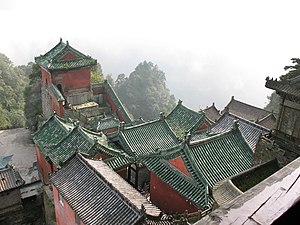 Image via Wikipedia
Image via WikipediaThe history of the Wudang Mountains is vast and legendary. But the birth of Taijiquan is nothing short of this also. It is attributed to a monk named Zhang Sanfeng. It is said he watched a snake and condor fight to develop the basics of the system. From his practice, he created 13 basic postures which were then passed down over the years to become all the different forms of Taijiquan you see today.
Chen Style's first master, Chen Wangting, attributes their initial master learning from a Daoist priest. In Baguazhang, the same is said of Dong Haichuan. But all of these martial arts have grown into many things over the centuries. The wide array of Taijiquan systems can be as different as Chen Style to Zheng Style. But the main form taught at Hundred Schools of Thought Martial Arts is unique in that they refer to it as the "mother form."
The idea of what Taijiquan is is spread across the internet, and the many Wikipedia links included in this article will be useful in explaining this. The main point for me to share is that Taijiquan is translated the fighting systems of the Taiji principles. The Taiji is the icon or symbol of Yin & Yang. This is the principle of Yin filling the space and flowing with the Yang force. Receptive and supple force listening and following aggressive and determined force. In this artform, the student learns to deal with attacks and aggression by becoming and utilizing the presence of Yin in every situation. Allowing the opponent's attacks to lead, while your force listens to their energy and allow them to fail.
HSOT-MA's Wudang Taijiquan Core Courses focuses on the develop of Taijiquan through the Wudang Sanfeng Pai 13 Principle Taijiquan Form. To break down this name a bit:
Wudang is used to represent it is of the Wudang moutains, a general term for the area from which the art comes from.
Sanfeng Pai is the Sanfeng sect of which the form has been passed through. My instructor in Boston, Zhou Xuan Yun, along with his brother at Wudang whom introduced me to the form, Chen Shiyu, are both 15th generation masters in this lineage.
13 Principles refers to the 13 principles of Taijiquan which Zhang Sanfeng is said to have developed. This is sometimes referred to as the 13 postures.
Taijiquan for the family of martial arts it is based in.
Form is a bit deceiving. It is taught as a form, and the motions are contained in the form. But each of the Wudang forms are complete systems of martial theory and their own style by many accounts. A master may focus and train on a single form their entire life, or learn a variety of forms.
This system though also can go by other names:
Wudang Taiji 13, Zhang Sanfeng Taijiquan, Wudang Taiji 13 Postures, and any other combination you can think of using these terms.
The 13 principles used in this form are beginning (qishi ), embracing a ball (baoqiushi), single pushing (dantuishi), exploring (tanshi), holding (tuoshi), pouncing (pushi), loading (danshi), separating (fenshi), waving (yunshi), dissolving (huashi ), pushing on both sides (shuangtuishi), pushing down (xiashi), & finishing (shoushi).
But the form is also broken down into 8 basic movements with 5 types of stepping. combining all of these together, the form reaches approximately 60 postures in length. Although some of this is repetition, the unbelievable variety in techniques is stunning.
This form also practices a line theory found in many martial arts. Unlike most Taijiquan forms, this form basically travels a line (with stepping off the line done onto a regular second line). This unique line theory offers students an interesting truth to help see all of the applications and ranges of the techniques clearly, as it is not complicating the form with additional directions and changes (other than learning important the turning principles).
Once completed, this form takes aproximately 7-10 minutes to preform at a moderate pace, and can be down quickly in approximately 3 minutes. Through your training in this form, the changes of pace and play of speed will help students develop higher skill, health, and application.
Move on to Part 2...
![Reblog this post [with Zemanta]](http://img.zemanta.com/reblog_c.png?x-id=db2b971e-9cef-4dee-8418-6cfa81db462f)




0 comments